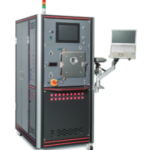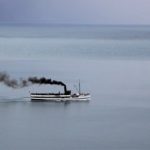Sputtering system is a deposition equipment applicable for sputtering technology, which is classified as a physical vapor deposition (PVD) method within the category of vacuum thin film formation.
Thin films produced by sputtering equipment feature excellent adhesion to substrates, high reproducibility when repeatedly depositing films, and the ability to produce materials and alloys with high melting points. In addition, it can produce oxide and nitride films as well as metal and insulating films, which are indispensable for functional materials such as semiconductors and electronic devices.
We design and manufacture high quality sputtering equipment that reflects the needs of our customers by applying the technology and strict quality standards we have proliferated over many years as a subcontractor for major vacuum equipment manufacturers to our own brand equipment.
[Characteristics of sputtering methods]
- The high collision energy of the material impacting the substrate results in a thin film with high adhesion strength.
- As the material sputters linearly in a fixed direction, there is less film adhesion to non-substrate surfaces than with other deposition methods. However, it is difficult for the film to adhere to the sidewalls of uneven surfaces.
- Easy control of film thickness by adjusting various conditions such as supplying power and deposition time.
- A film of uniform thickness can be produced over a large area.
- High-melting-point materials and insulating films can also be deposited.
- Compared to evaporation systems, which melt materials at high temperatures when making alloys, changes in the composition of the material are less likely to occur.
- Reactive sputtering which combines nitrogen, oxygen, hydrogen, etc. takes care of deposit compound films as well.
- Plasma cleaning (reverse sputtering) on the deposition surface of the substrate is also possible by applying high voltage to the substrate holder
- Lower deposition speed (deposition rate) than the evaporation method.
Contents
Product information on [SSP2000Plus].
SSP2000Plus is a sputtering system for R&D.
It is used in research and development applications such as metal films, insulating films, conductive films, insulating films, protective films, reflective films, catalysts, coatings, circuits, batteries, MEMS and new materials.
As it is equipped with a substrate heating mechanism of MAX 300°C, it can be selected as a high-end model of SSP1000, which does not have a substrate heating mechanism.
[characteristic 1] 2-way cathode
It carries φ 2 inches magnetron cathodal two engines (with a shutter) and achieves less than film thickness distribution ±5% within φ 100mm.
By switching the discharging cathode, this equipment can also be used for layered deposition.
[characteristic 2] substrate heating mechanism of MAX 300°C
For the function of substrate heating, which determines film quality, a heater with a standard specification of MAX 300°C is installed, enabling high quality film deposition.
*SSP3000Plus and SSP3000 are capable up to MAX 800°C substrate heating as the option.
[characteristic 3] RF power supply
The high-frequency RF power supply with pulse oscillation function enables stable deposition even on targets made of insulating materials, which are prone to abnormal discharges.
[characteristic 4] Extensibility
It has a port on the side of the unit for additional equipment, which can be connected to the transfer unit STR2000 to provide a load lock function room.
It can also be combined with Plus series sputtering, ALD, annealing and evaporation equipment, enabling a variety of deposition processes without exposing the substrate to the atmosphere.
[characteristic 5] Touch screen program for intuitive operation
The GUI (Graphical User Interface) type program is adopted for intuitive understanding by operators, providing visibility of various statuses, including operating status, and operability for easy adjustment of valves and setting items.
The status of the equipment can be easily monitored on the status screen during the process.
It is equipped with a touch panel program that secures both easy operation and safety, with various interlocks and alarm functions.
In response to the ever-changing nature of research and required modifications, the program itself is designed to be easily modified afterwards, thereby reducing design costs when it’s needed to be updated.
[characteristic 6] Slim tower design with a small footprint
The deposition chamber, exhaust system and control system are combined into one slim tower, measuring 608 mm (W) x 800 mm (D).
Compared to equipment with a separate main unit and control rack, the rear of the equipment has a cleaner appearance with no excess wiring exposed.
It’s easy to move and reduce man-hours (=expenditure) when relocating or changing the room layout after installation.
Standard specifications for [SSP2000Plus].
SSP2000Plus Specification
SSP2000Plus Outer dimension
Options for [SSP2000Plus].
①magnetic deposition
When depositing films with magnetic materials such as iron (Fe), a stable plasma discharge cannot be achieved with standard magnetron cathodes.
This option allows a choice of cathode specifications for magnetic materials.
Even after the equipment has been installed, both magnetic and non-magnetic materials can be used by replacing parts.
②support for thin targets
Our cathodes are ø50.8 mm x t3 mm geometry as the standard, but making a 3 mm thick target of expensive material can result in high expenditure.
If you want to reduce target expenditure or know from the outset that the number of depositions will be small, shields and target holders for thin targets such as 1 mm and 2 mm are available upon the requiesst.
※Some materials are difficult to discharge on thin targets.
※Note that if a thin target is sputtered in combination with the standard parts for 3 mm thickness, an abnormal discharge may occur in the extra gap created between the target and the shield, and deposition may not be achieved.
③additional gas introduction systems
Two additional process gas introduction systems can be added, making a maximum of three systems.
This option is required when performing reactive sputtering by introducing oxygen, nitrogen, etc.
④Up-grade to a dry pump
The auxiliary pump can be replaced from a rotary pump to a dry pump.
Basically dry pumps are required under the condition of cleanroom installation
Our selection of non-contacting, multi-stage Roots dry pumps ensures maintenance-free, clean exhaust air for a long time after installation.
Repair and modification for [SSP2000Plus].
Even after the equipment is installed, we are fully prepared to meet any request.
Within the stipulated warranty period after delivery of the equipment, we will repair free of charge any initial defects or other faults that are not covered by certain conditions stipulated by us (failure due to natural disasters or improper use, etc.).
For more information, please contact us.
[Example of repair and maintenance menu]
- Routine maintenance and service response in case of malfunction
- Remodeling or adding functions to equipment and modification of the program software associated with such work
- Relocation of equipment and layout changes
- Operational training (e.g. when the person in charge of operations is replaced)
- Purchase of consumables
- Cleaning and re-blasting of the film on shielded components
- Questions to be answered by email, telephone, etc.
[Modification]
Even after the equipment has been installed, we can also provide services related to modifications due to changes in the content of experiments or conditions of use.
Examples of modification
- Combined with another device via a transfer unit (Plus series)
- Various functional additions/changes and parts replacement
- Production of sample holders for special shapes
- Program improvements and updates
- Additional gas introduction systems
- Replacement of rotary pumps with dry pumps
- Larger auxiliary pumps
- Additional cooling water circulator (chiller)
- Other remodeling and On-site services on request




